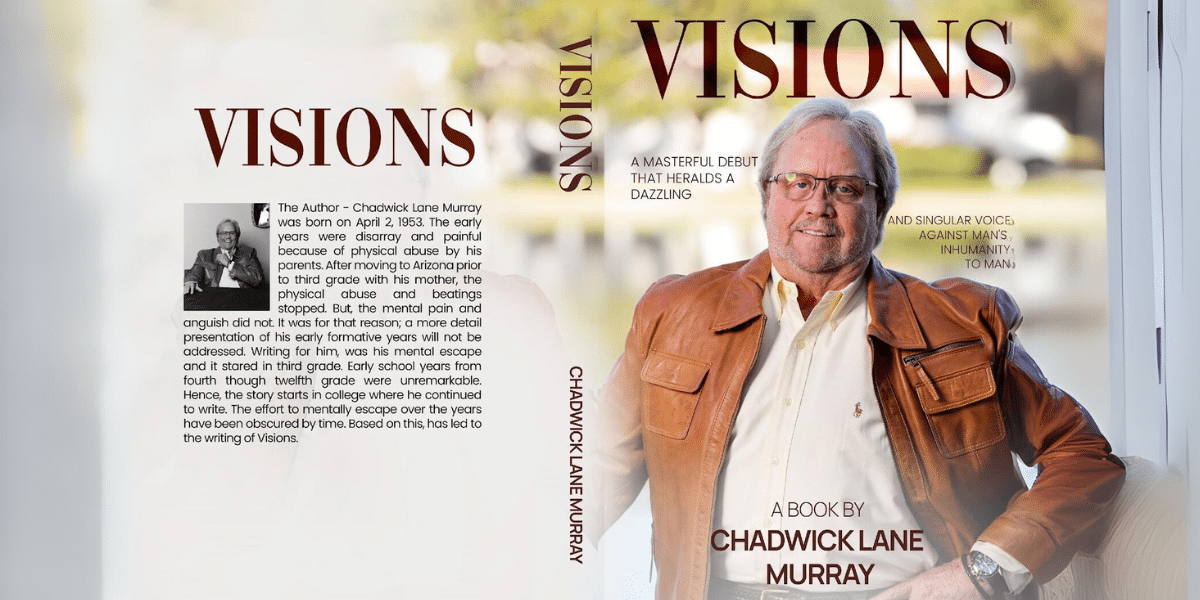Experiences significantly impact people’s lives, shaping their ideas, values, and emotional depth. Authors often rely on their own lives and the experiences of others to produce rich, realistic novels and books. By combining personal accounts with historical and present events, authors bring diverse themes to life, promoting empathy and understanding in their readers. These lived experiences serve as a source of inspiration, enabling writers to approach challenging topics with sincerity and subtlety. They bridge the gap between fiction and reality by telling fascinating tales while providing essential insights into the human condition. One such author is Chadwick Murray, who wrote his debut book “Visions,” using his experiences while reflecting on social injustice and the human condition.
In a society beset with social disparities and rising global tensions, Chadwick Murray’s first book, Visions, emerges as a fascinating story delving into humanity’s darkest sides. This book examines past injustices while finding unsettling connections to our own concerns.
Chadwick Lane Murray was born in Milwaukee, Wisconsin, on April 2, 1953. His early years were anything from the ordinary. His youth was blighted by physical abuse, which left lasting scars. However, a transfer to Arizona before the third grade provided some comfort; the abuse stopped, but the emotional pain remained.
Murray’s educational journey took him to Arizona State University, where he received a Bachelor of Science in Business. His academic goals did not end there; he also began a Ph.D. in Environmental Engineering, portraying his intellectual rigor and commitment to understanding complicated systems.
Murray has been a real estate consultant for 47 years, earning the renowned MAI accreditation from the Appraisal Institute when he was just 26 years old. The Member of the Appraisal Institute honor demonstrates his knowledge and devotion to his profession.
Murray planted the seeds of his first book in his head as a kid. Writing became his escape, a haven from the brutal reality of abuse. The notion for the novel was established in third grade, fueled by personal letters from troops killed in action during various wars and conflicts, including World War I, World War II, and Vietnam. Frequently aged and bloodstained, these heartfelt letters told volumes about fear, hope, and the human experience.
Murray’s book concept began in 1962, inspired heavily by George Orwell’s dystopian classic Nineteen Eighty-Four. While Orwell’s book imagined a future ruled by a dictatorship or a totalitarian government, Murray’s vision goes deeper, investigating society’s moral and social fabric. His views on historical and present injustices took almost a decade to complete.
Visions is not an ordinary run-of-the-mill or typical book. It is divided into self-contained parts that address a distinct facet of social injustice. These parts, which range from 5 to 20 pages long, enable readers to dig into various elements without following a chronological development. This approach makes the book more accessible and entertaining, thoroughly investigating injustice from many perspectives.
At the heart of Visions is an investigation of three fundamental components of justice: the reduction of arbitrariness in authority, the equal allocation of resources, and the successful rectification of wrongs. Murray weaves these concepts throughout the book, delivering a sophisticated analysis of contemporary systems.
Murray’s book opens with observations on World Wars I, II, and the Vietnam War. Although he never served in Vietnam, his contributions to the war effort as a college student working for Motorola’s federal electronics branch gave him a unique viewpoint. Murray dealt with the harsh reality of war and its far-reaching implications while designing guidance systems for surface-to-air missiles.
The work is mainly based on actual events, especially the turbulent 1960s. Murray vividly recounts the assassinations of prominent leaders who advocated for peace and justice, including John Kennedy in 1963, Malcolm X in 1965, Martin Luther King Jr. in 1968, and Robert Kennedy in 1968. According to Murray’s book, these losses indicated a culture that was averse to change and progression.
Murray’s Visions is more than simply a reflection on past and current injustices; it is a call to action. He encourages readers to challenge the status quo and seek justice in an unjust and unequal society. His message is clear: humanity must strive for a future in which peace and justice precede wealth and power.
The book’s conclusion, influenced by sociology professor Thomas Ford Hoult, provides practical ideas for dealing with societal inequities. Hoult’s observations are smoothly incorporated into Murray’s book, creating a road map for transformation.
Visions, which targets young urban professionals and history buffs, has gained traction for its informative and thought-provoking material. Early reviews laud Murray’s ability to integrate complicated theory and real-world examples into a fascinating story. The book’s innovative format, which allows for non-linear reading, has been warmly welcomed.
Chadwick Murray’s path from a troubled upbringing to becoming a prominent author exemplifies perseverance and persistence. His book, Visions, encourages readers to think critically about the problems that shape our society. It is a frightening reminder of the ongoing battle for justice and the human spirit’s ability to overcome hardship.
In an age where social inequalities persist, Murray’s Visions provides both a reflection on the past and an optimistic vision for the future. It is a must-read for everyone who wants to understand and combat the complexities of social injustice.

